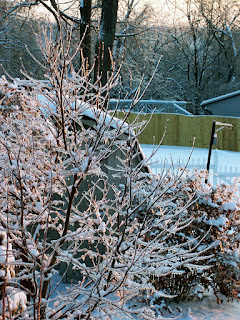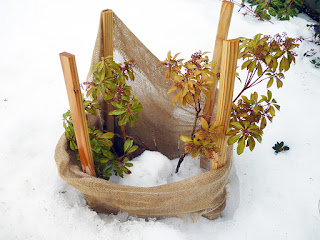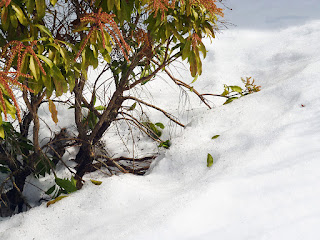Have you ever wondered how the trees and shrubs and perennials manage to live through each winter? Think about it. If they hadn’t adapted to those conditions, we’d live on a barren planet.
 |
| Rhododendron leaves curl up to prevent desiccation from extreme cold weather and drying winds. |
Our trees, shrubs, and perennials enter a period of dormancy as days shorten and temperatures cool in the fall. During this period, woody plants must have a certain number of hours of temperatures below 40˚F in order for them to come back in the spring. Many species in the Midwest and Northeast do not attain full dormancy until mid-November or December. Unexpected cold snaps in early fall or late spring will damage plants that either have not entered full dormancy, or have begun spring growth. A perfect example is the devastating effect of the unprecedented 2016 Polar Vortex, when temperatures dropped into the minus-single-digits for several nights in some places. The true consequences of this event might not be known for a couple of years.
Snow is good, but ice can be lethal
Not only does snow replenish the soil with moisture, but snow has great insulation properties that slow down the loss of heat from the ground. In an ideal winter, our plants have gone dormant long before the ground begins to freeze. Followed by a comfy blanket of snow, this frozen soil remains right around 32 degrees, and those plants and shrubs have a long rest before they’re required to perform again. Ice is quite another thing. |
| Branches "glazed" with thick ice. |
Ice storms, also known as “glaze storms” or “silver thaws,” can cause devastating damage to trees and shrubs. When surface temperatures remain at or below the freezing point (32˚F/0˚C), rain freezes on contact, sometimes accumulating up to 1 inch. This heavy layer can increase the weight of a tree branch up to 30 times, making it prone to breakage. Add a strong wind, and the chances of losing an ice-covered branch increase exponentially. Branch loss also reduces the total leaf area, reducing the carbohydrate available to the roots. Exposed bark is subject to sunscald and infestation by stem borers and other insects, while breakage wounds are open to decay, fungi, and crown gall bacterium.
Which Plants are at Risk?
According to the United States Forest Service, trees with a conical form, or excurrent branching habit, and those species with less branch surface area are the least likely to sustain damage from ice accumulation. Horizontal branching seems to resist breakage better than upright branching. Fast-growing trees have brittle wood and develop V-shaped crotches that easily split.Prevention or repair?
Nothing can be done to prevent damage to mature trees. However, planting storm-tolerant varieties in a new landscape is one way to guard against dealing with the ravages of ice and snow. Learn which local species will grace your landscape and survive the winter weather. Plan ahead when planting tall trees, positioning them at least 45 feet from overhead utility wires. Prune them regularly to establish a well-distributed crown branching habit. Occasional light pruning of older trees might help them resist ice damage. Weak branches and interior branches can be removed before winter sets in, but avoid late summer pruning which will stimulate new growth. |
| Young shrubs benefit from protection too. |
Choose hardy native plants, and carefully assess their proposed location. Easily-injured broadleaf evergreens such camellia, azalea, rhododendron, holly, and daphne should be located on the north, northeast, or eastern side of a building or fence to protect them from wind and sun. Low places in the landscape create frost pockets and can accumulate excess moisture around the roots. Don’t place shrubs under the eaves of the house – snow and ice can slide off onto the plants, and overflowing gutters can drench shrubs in heavy ice during freezing weather.
For small upright evergreens with multiple leaders, such as arborvitae and juniper, or clump trees such as birch, protect them by wrapping the leaders together about two-thirds above the weak crotches, using something soft (strips of cloth, nylon stockings, etc.) Be sure to remove the strips in the spring. A professional arborist can prepare larger, wide-spreading trees by cabling the branches together.
Damage control
 |
| Andromeda branches bent low under snow. |
When the snow has melted, remove broken branches as soon as possible to prevent further breakage or tearing of the bark. Trees don’t heal – the bark grows over the damaged area. Hence, proper cleanup of a broken stem is important. Smooth the ragged edges of the dead bark using a sharp knife, removing the bark back to its attachment point. Tree experts have determined that wound dressings neither prevent decay nor keep out insects. During a 13-year research project, Dr. Alex Shigo found that leaving the tree alone was more beneficial than applying wound dressings, and that many products such as shellac, paint, or roofing tar actually damaged the tree.
Can it be saved?
 |
| Trees heavily weighted with snow |
For catastrophic damage, major tree repair is expensive. If the tree is an important part of the landscape and more than 50% of its branches remain intact and undamaged, then the choice might be to save it. But if the condition of the tree is such that it will fall victim to either future weather or disease/insect damage, one must consider that into the decision. Large limbs can weigh over 2,000 pounds and most mature trees should be dealt with by professional tree services.
When the storm is over and the repairs and removals are finished, be sure to continue evaluating and nurturing the recovery of damaged plants. Supplement rainfall to 1-inch per week, mulch to conserve moisture, and avoid excess soluble nitrogen fertilizer (less than 2 pounds actual nitrogen per 1,000 square feet, per University of Missouri Extension. Storm-damaged plants can be victim to insects and diseases, so check for symptoms and signs, then act quickly to minimize further damage.
Winter always comes in one form or another, and being knowledgeable and prepared for the worst is the best defense.


No comments:
Post a Comment